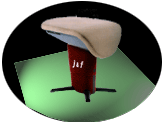|
 Vaulting techniques for
men and women
on the vaulting table Pegases Vaulting techniques for
men and women
on the vaulting table Pegases
The FIG has decided to introduce a new
vaulting apparatus:
 Offering more safety through improved support conditions and
view on the apparatus, creating the possibility to perform the present
vaulting repertoire on a technically higher level, through which a
higher level of execution and stability can be demonstrated.
Offering more safety through improved support conditions and
view on the apparatus, creating the possibility to perform the present
vaulting repertoire on a technically higher level, through which a
higher level of execution and stability can be demonstrated.
 One identical apparatus for men and women and suitable for the next
generation of gymnasts.
One identical apparatus for men and women and suitable for the next
generation of gymnasts. Accomodating the present vaulting repertoire and simultaneously
allowing a further development in variation of vaulting exercises (e.g.
take-off – turn – support) without a trampoline effect.
Accomodating the present vaulting repertoire and simultaneously
allowing a further development in variation of vaulting exercises (e.g.
take-off – turn – support) without a trampoline effect. Allowing an expansion of variations in exercises through fast changes
of the body angle at the take-off and at the push-off phase,
especially for women.
Allowing an expansion of variations in exercises through fast changes
of the body angle at the take-off and at the push-off phase,
especially for women.
 Some first thoughts and directions for the use of the vault Pegases
Some first thoughts and directions for the use of the vault Pegases
1. Approach
- The vaulting table is slightly tilted,
offering the gymnasts a better view on the support area during the
approach, and allowing a better anticipation for the push-off.
- The sloping upholstered front
protects the gymnast in case of a miss at take-off. The coloured
bottom part of the front is not dynamic and therefore and for reasons
of limitations of stress not intended to be a push-off
area.
- The sloping shape of the front offers a
good view of the landing area and allows the gymnast to run passed the
apparatus, reducing the risk of a collision.
2. Support area
- The dynamic characteristics are similar
to those of the present vaulting horse, preventing a trampoline effect.
- The width and length offer optimal
safety conditions for a technically perfect execution of the present
vaulting repertoire.
- When adopting a similar technical
approach for kasamatsu and tsukahara techniques as in
men’s gymnastics, this could result in a technically important
development impulse for women and young gymnasts.
- The exercise: take-off and turn (axial
and vertical) before the support phase, ( already been practised
about 20 years ago. Resulted in a low valuation for reasons of
insufficient support area and therefore lack of amplitude in the
second flight phase) could be introduced again as vault
group. ( see code of points 2001).
- The dimensions of push-off area
allow for a shoulder wide support. This guarantees that the forces
occuring at push-off will go into the body versus the present
situation where the forces partially leave the body above
the shoulder, resulting in excessive strain.
- It should be recommended to female
gymnasts to abandon their present techniques for forward and backward
handspring vaults, kasamatsu and tsukahara vaults.
No
support against the front part of the vaulting apparatus
(as practised with the present
vaulting horse)
Support position
of the hands: slightly turned inward
| . |

Both technical characteristics reduce
the stress on the joints (hands-ellbows-shoulder) offering
gymnasts – especially women- more protection against exessive
strain and therefore a limitation of stress.
|
3.The use of the
vaulting table Pegases for young gymnasts
The introduction of the new vaulting
apparatus raised objections from some junior female trainers: “the table
is too long”
.
These objections as a thought should be
justified, but cannot be held upright in training practice.
|
Why
?
|
| 1. |
In
relation with the long term preparation of gymnasts in the age
from 6-9 years, other assignments in the development of
pre-requisites than vaulting on the new apparatus are more
essential. (run-up, pre-flight, turning techniques) |
| 2. |
Untill now,
children (male and female) did not use the competition
vaulting horse. They used amongst others vaulting boxes and stacks
of mats as competition apparatus. |
| 3. |
Opposed
to the present vaulting horse, which has a minimum height of
110 cm, the new vaulting table offers a height of 95 cm. |
| 4. |
Its is
however necessary to aim for the approximate centre of the
new vaulting table and not push-off against the front edge. |
| 5. |
The
video shows that 9 year old male and female gymnasts of an average
level are using the vaulting table without any problem after only
15 minutes of training. |
|
D. Hofmann /Janssen
& Fritsen December 2000 |
|

 VAULT
VAULT
 Vaulting techniques for
men and women
Vaulting techniques for
men and women Offering more safety through improved support conditions and
view on the apparatus, creating the possibility to perform the present
vaulting repertoire on a technically higher level, through which a
higher level of execution and stability can be demonstrated.
Offering more safety through improved support conditions and
view on the apparatus, creating the possibility to perform the present
vaulting repertoire on a technically higher level, through which a
higher level of execution and stability can be demonstrated.
